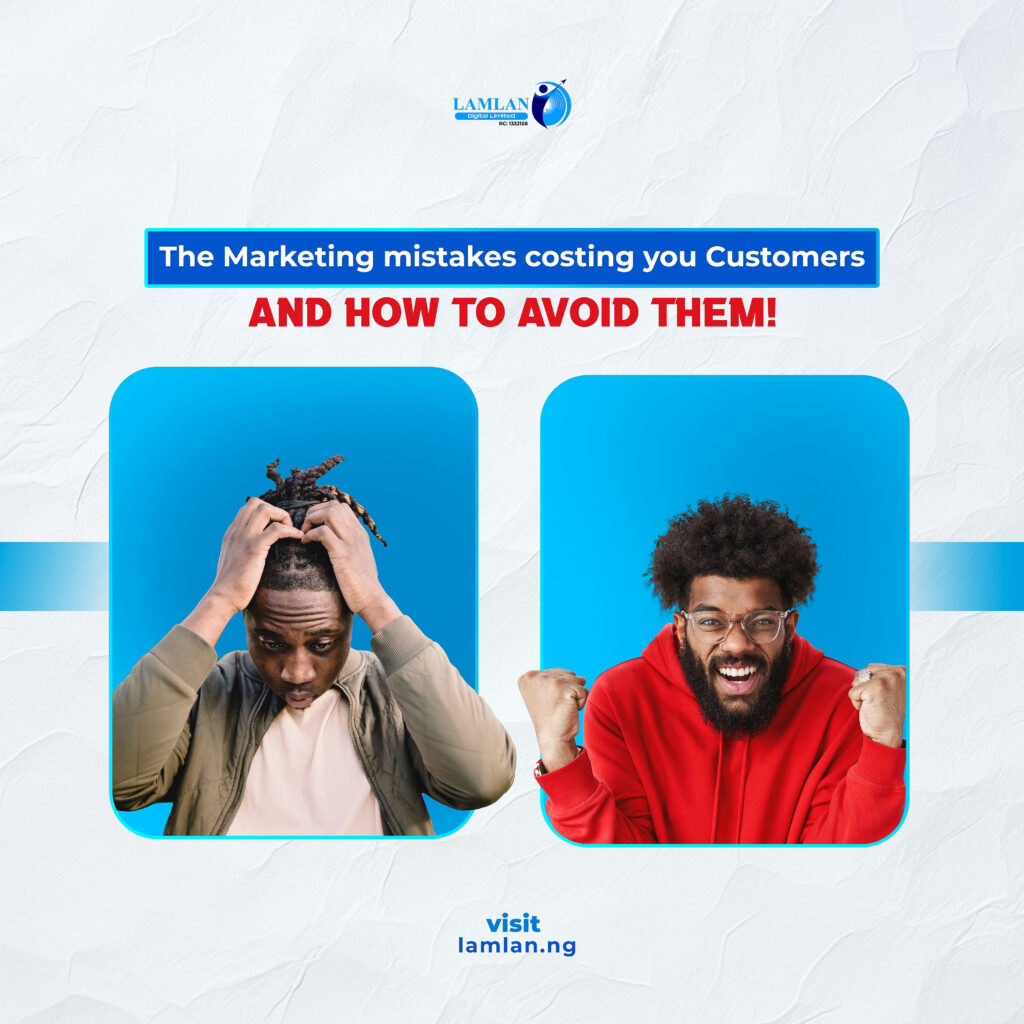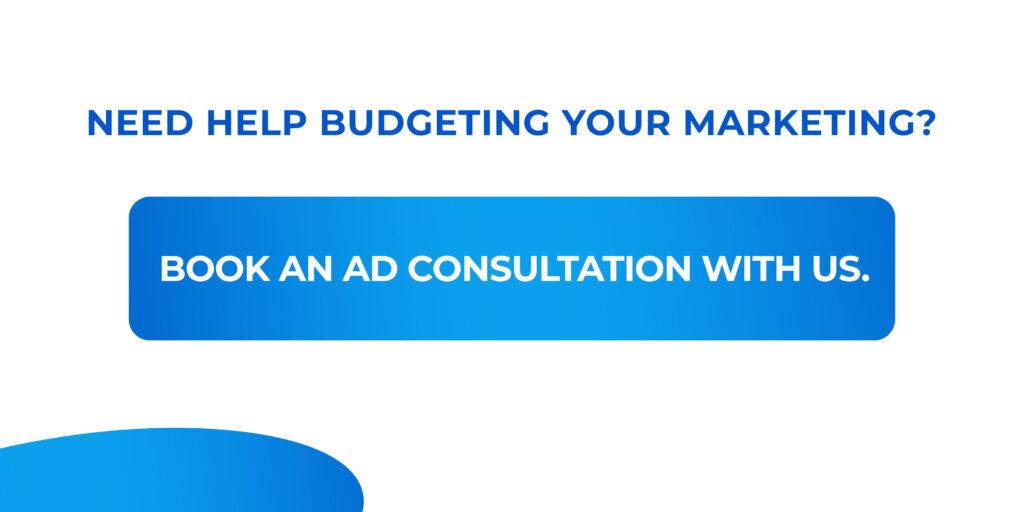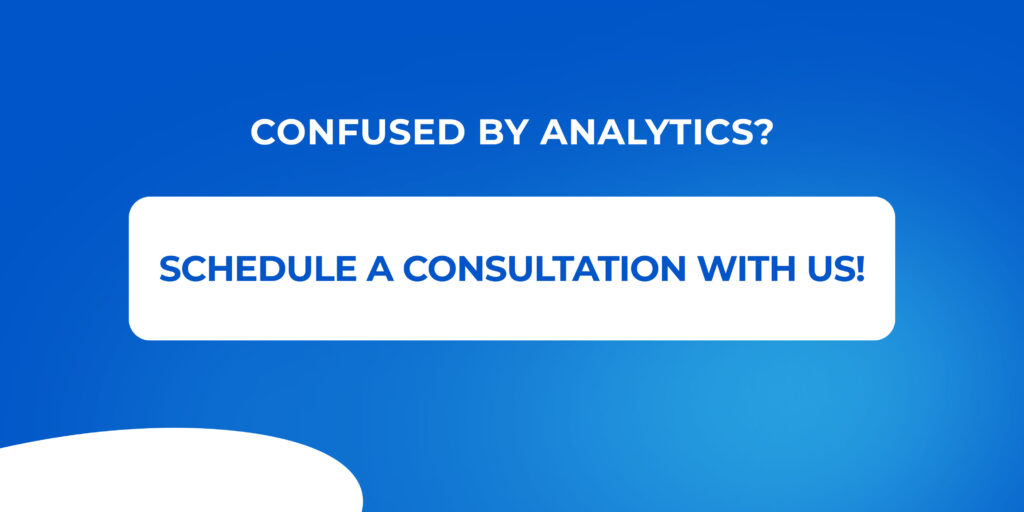
In today’s fast-paced digital world, getting your marketing strategy just right is more important than ever. Yet, many businesses unknowingly make mistakes that drive potential customers away. The good news? These mistakes are avoidable!
In this post, we’ll break down 6 common digital marketing mistakes and share practical tips on how to avoid them— so you can turn things around and grow your business!
Let’s dive in!
Mistake #1: Speaking to the Wrong Crowd
Many businesses make the mistake of casting their nets wide in an attempt to draw in as many clients as possible. While this sounds brilliant on paper, the reality is that it is counterproductive to your marketing goals. If you don’t know your target audience, your marketing might miss the mark!!
Imagine running a women’s hygiene brand and aiming to reach everyone. You’ll end up marketing to people who do not need for your products—like targeting men or kids. The result will be a lot of effort and no sales.
Solution: Get To Know Your Audience!!
Instead of trying to sell to everyone, take the time to zero in on your ideal buyer or client. Who are they? What do they care about? What are their hobbies, and how do they spend their time? This level of understanding is key to creating content and strategies that resonate with the right people.
How to Define Your Audience:
- Create Buyer Personas
A buyer persona is a detailed representation of your ideal customer, and it’s a game-changer for businesses looking to refine their marketing. These personas are like mini profiles that outline things like age, gender, location, occupation, hobbies, and even challenges they face and this can be achieved through market research. The clearer you are about who they are, the more effectively you can tailor your marketing efforts. - Map Out Your Ideal Customer
Beyond basic demographics, think about your customer’s journey. What are their pain points? What drives them to seek out solutions? Where do they hang out online? For example, if you’re selling high-end skincare, your ideal customer might be a 30-something professional who values self-care, spends time on Instagram and Pinterest, and is interested in wellness trends. With this information, you can craft messaging that speaks directly to their needs and interests. - Tailor Your Message to Specific Segments
Once you’ve defined your audience, you can create personalized marketing strategies for each segment. Not all buyers are the same, even within your target market, so tweak your messaging to reflect their unique needs. For instance, a younger buyer may care more about eco-friendly packaging, while an older buyer may focus on the product’s effectiveness for mature skin.
By understanding your audience inside and out, you’ll create targeted campaigns that drive engagement and, most importantly, lead to sales.
Mistake #2: Expecting Immediate Results
In our fast-paced digital world, many businesses expect instant results from their marketing efforts. While quick wins may sound appealing, focusing solely on short-term gains can backfire. Prioritizing immediate results often leads to overlooking the strategies that build lasting relationships and brand loyalty.
Marketing success takes time, consistency, and often multiple attempts to truly engage your audience and convert them into paying clients. Instead of getting discouraged by delays, remember that patience is key—long-term growth requires a steady, strategic approach.
Solutions
Instead of banking only on short-term results, balance your approach with both short- and long-term strategies:
- Short-term Strategies (Quick Wins): Running paid ads, promotions, or giveaways can give you a short-term boost in visibility and engagement. These are great for attracting immediate attention or creating a buzz around your business or a special campaign, but they won’t build a sustainable brand on their own.
- Long-term Strategies (Steady Growth): Focus on building organic traction through SEO, high-quality content, and especially community engagement. Optimizing your website and social media platforms for search engines and producing valuable, consistent content will ensure that you remain relevant to your audience over time. While these strategies take a bit longer to pay off, they’re crucial for creating lasting brand visibility and credibility.
The key is to stay consistent and strike a balance between short bursts of success and long-term strategies that keep your brand growing steadily. Think of marketing as a marathon, not a sprint!
Mistake #3: Inconsistent Branding Across Platforms
When your brand tone, logo, and messaging across social media platforms are inconsistent, it can:
- Confuse your existing audience
- Turn off potential clients
- Weaken trust in your brand
It’s crucial for your brand to maintain uniformity across all channels.
Branding is not just about logos and graphics. It encompasses:
- Visual Identity: Logos, colors, and design elements
- Brand Values: Core principles and mission
- Customer Service: How you interact with and support your customers
- Community Engagement: Your involvement and presence within your community
- Tone and Messaging: The style and voice of your communications
Together, these elements create a recognizable identity and build trust
For example, think of Chicken Republic. When you think of them, you probably associate them with “affordable food,” right? And when you hear the catchphrase “Nice Nice,” it immediately reminds you of Chicken Republic.
These are elements of their brand identity, helping clients:
- Recognize their brand
- Connect emotionally with it
- Build loyalty over time
Without consistent branding, these associations become muddled, leading to confusion and a lack of brand loyalty. A disjointed brand identity weakens trust, making it harder for potential clients to relate to or remember you.
Solution
To avoid these issues, here are some practical steps:
- Create a Brand Style Guide:
Document your brand’s visual elements, values, tone, and messaging framework. - Consistency Across Platforms:
Use the same logo, colors, tone, values, and messaging on all social media platforms. - Stick to Guidelines:
Ensure every post, ad, or interaction aligns with your brand’s identity.
By keeping your branding cohesive, you reinforce your brand identity and build long-term trust with your audience.
Mistake #4: Not Having a Budget for Marketing
Many small businesses make the mistake of overlooking the importance of a dedicated marketing budget. Instead, they leave their marketing efforts to chance, hoping for a viral post to boost their sales overnight. While it’s true that some businesses have seen success with viral content, relying on this alone is not a sustainable strategy for consistent sales growth.
Solution: Build a Marketing Budget That Works for You
- Start Small:
Begin with a modest marketing budget that fits within your financial constraints. Focus on strategies that offer good returns for your investment. - Set Clear Goals:
Define what you want to achieve with your marketing efforts—whether it’s increasing brand awareness, driving traffic, or generating leads. - Track and Adjust:
Monitor the performance of your marketing activities. Adjust your budget and strategies based on what works best for your business. - Scale Gradually: as your revenue grows, consider increasing your marketing budget. Invest in more sophisticated strategies and tools to expand your reach and enhance your effectiveness.
By allocating a specific budget to marketing, even if it’s small at first, you set the foundation for more controlled and strategic growth. Over time, this approach will help you build a more reliable and effective marketing presence, leading to sustained business success.

Mistake #5: Neglecting Data and Analytics
It’s not enough to just have a marketing budget and a strategy — you also need to track your results to see what’s working and what’s not.
Thankfully, many platforms like Instagram, Facebook, and Google offer built-in analytics tools that help you monitor the performance of your marketing campaigns.
Why Tracking Matters
- Avoid Wasting Resources: By tracking your results, you can quickly identify which marketing strategies are effective and which ones are underperforming. This allows you to focus your efforts (and budget) on what works, rather than wasting resources on campaigns that aren’t delivering results.
- Data-Driven Decisions: Analytics give you insight into your audience’s behavior, showing what content resonates with them. This helps you adjust your strategy based on data rather than guesswork, enabling you to do more of what’s working and less of what isn’t.
Solutions: How to Make the Most of Data and Analytics
- Use Built-In Analytics:
Take advantage of the analytics tools available within platforms like Instagram, Facebook, and Google. These tools provide valuable data such as:- Post reach
- Engagement rates (likes, comments, shares)
- Audience demographics (age, location, interests)
- Click-through rates
- Track Specific Metrics:
Focus on key performance indicators (KPIs) that matter to your business. For example:- Engagement Rate: To see how well your content is resonating with your audience.
- Conversion Rate: To understand how many people are taking action, like visiting your website or making a purchase.
- Reach: To track how many people your campaign is reaching over time.
- Adjust Your Strategy:
Once you’ve gathered enough data, use it to adjust your strategy. If certain posts or ads are underperforming, tweak your approach to better align with what your audience responds to. If a particular type of content is getting high engagement, consider investing more into similar campaigns. - Seek Expert Help:
If you’re feeling stuck or unsure of how to interpret your analytics, consider booking a consultation with a marketing expert. Our ad consultation service can help you make sense of the data and refine your strategy for better results.
By leveraging analytics, you can eliminate the guesswork and ensure that every marketing dollar is well spent, driving your business toward growth and success.

Mistake #6: Not Setting SMART Marketing Goals
One of the most common mistakes small businesses make is diving into marketing without clear, actionable goals. This often leads to scattered efforts, wasted resources, and minimal results.
If you’re not working toward something specific, it’s easy to lose focus and overspend on strategies that may not even align with your overall business objectives.
Solution: Set SMART Marketing Goals
To ensure that your marketing efforts are focused and effective, it’s crucial to set **SMART goals**—goals that are Specific, Measurable, Achievable, Relevant, and Time-bound. Here’s how each element works:
Specific
Define clear and detailed goals. Vague objectives like “get more customers” won’t guide your strategy or help you track progress.
Example: “Increase website traffic by 25% in the next 3 months.”
Measurable
Your goals should be measurable so you can track progress and assess whether you’re on the right path. Leverage tools like Google Analytics or Instagram Insights to see real-time data on your marketing efforts.
Example: “Use Google Analytics to track a 25% increase in website traffic over the next 3 months.”
Achievable
Set goals that are realistic given your resources, timeframe, and current standing. While it’s great to be ambitious, setting unachievable goals can lead to frustration and wasted effort.
Example: Instead of aiming for ‘a 300% increase in sales overnight’ which is unrealistic, aim for a manageable 10-20% growth in a quarter.
Relevant
Ensure your marketing goals are aligned with your broader business objectives. If your main goal is to increase sales, your marketing strategies should focus on lead generation and converting traffic, not just increasing brand awareness.
Example: If you aim to increase sales, prioritize strategies like paid ads targeting potential buyers over a general increase in followers.
Time-bound
Set a clear timeline to achieve your goals. Having a deadline creates urgency and helps you stay accountable, making it easier to assess progress and make adjustments if needed.
Example: “Increase website traffic by 25% by the end of Q4.”
Setting SMART goals gives your marketing efforts structure and purpose. They allow you to:
- Stay focused on specific targets rather than spreading your resources thin
- Track progress and know exactly when and how to adjust strategies
- Ensure realistic expectations so your team remains motivated
- Align your marketing with broader business goals, ensuring a higher return on investment (ROI)
By setting SMART goals and tracking your progress, you ensure that every marketing effort has a purpose and a measurable outcome. This not only saves time and resources but also sets your business up for sustained growth.
Making digital marketing mistakes can be very costly—but the good news is they’re avoidable. By recognizing and addressing these common pitfalls you can set your business on a path to long-term success.
Taking proactive steps to improve your marketing strategy will not only help you reach more customers but also enhance brand loyalty and drive sustainable growth.




